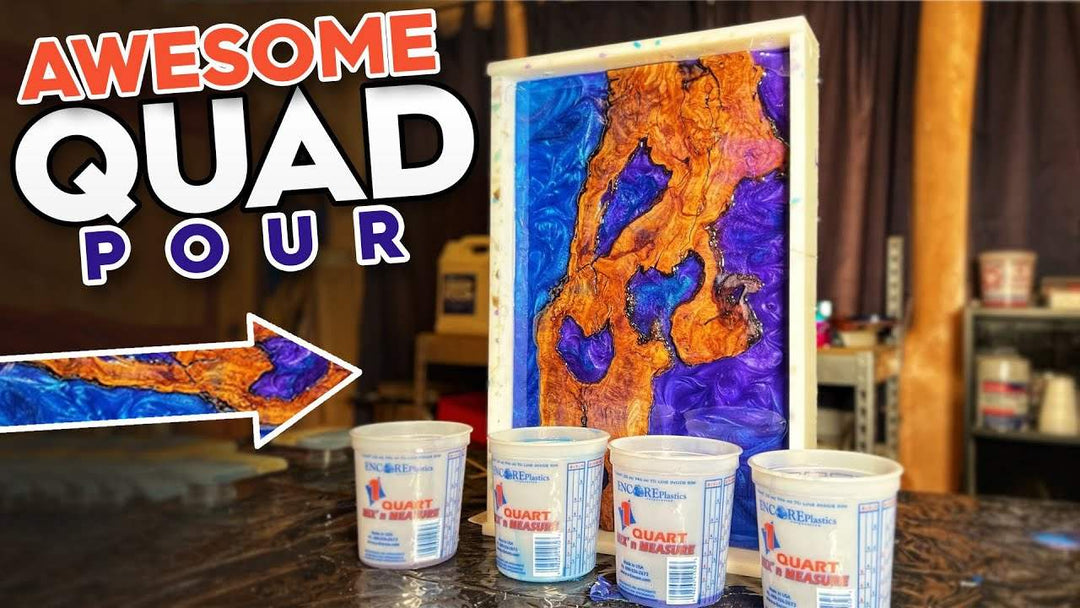
What To Know About Epoxy Drying Times
How Long Does Epoxy Take To Dry?
Are you ready to get started on your next project involving epoxy? Before do your resin pour, there are some things that you will want to know. From river tables and other epoxy table tops to chic jewelry, you can find a wide variety of uses for this product. With any type of epoxy, understanding the drying time is a vital factor.
You might be asking yourself, "How long does epoxy take to dry?" For a professional look, you want the epoxy to dry and cure in the proper amount of time. Let's take a look at this great product and provide some tips to create your next masterpiece.
Epoxy Drying Times
The dry time of the epoxy depends on the brand and the specific type of epoxy resin that you are using for the project. Upstart Epoxy Deep Pour has a flexible dry time of 6 hours, while the Art Resin features a fast 30 minute working time. In any case, you need to read the instructions carefully to determine the correct time for your product.
Some people want to sand down the resin or move the piece to another location. If the epoxy is not set, then those actions can damage the project, including attracting dust particles to the surface. You can expect to wait about 72 hours for the epoxy to be fully set.
Can I Dry the Resin Faster?
Now that the question of "How long does it take for epoxy to dry?" has been answered, you might want to know if you can speed up the process. Waiting for the epoxy resin to cure can be frustrating. However, there are a few things that you can do to reduce the epoxy's dry time, but before you attempt this, you need to read all the manufacturer instructions on the product.
When selecting the right epoxy for your project, you must know its specific curing time. There are plenty of products that cure fast, but you will have to work with them quickly. These epoxies contain more curing agents than other products. Some might even harden within a few minutes, and there is no room for mistakes. If you are confident in your skills, then try your hand at the faster curing products. If you do mess up, learn how to fix your epoxy mistakes. But the best thing to do is to get it right from the beginning.
Raising the epoxy cure temperature could speed up the process as compared to normal air-drying process. Some people will use a heat gun or hairdryer. However, you want to be careful with these methods. You can remove air bubbles with added heat, but it can also lead to cracks in the surface.
Heat is a great way to expedite the curing process. You will want to keep your project in a room with a high temperature. In some cases, the extra heat could cut that drying time in half. Think about adding a heat lamp to provide more warmth for your space.

Challenges To Epoxy Curing
Some circumstances can increase the curing time of your epoxy. You might inadvertently make a mistake and extend the curing process for your project.
One common mistake is adding another curing agent to the epoxy. Most epoxies have their own curing agents, and if you add more hardeners to the mixture, you will be left with a mess and less time to complete your project.
When you add color to the epoxy resin, it can extend the curing process. You want to make sure that the color makes up less than 7 percent compared to the resin and curing agent. With these measurements, you can retain your desired texture with a timely curing process.
You also want to stick to the same brand and never "mix and match." Using a resin and curing agent of a different manufacturer, you could create a concoction that will not set.
Along with that, your quantities need to be precise. If you add too much epoxy to your project, it can throw off the ratio and lead to longer curing times.
Factors Affecting the Dry Time
As you may have already known, certain factors affect the dry time of the epoxy. You need to pay attention to the temperature and hardening agent to achieve the perfect results for your project.
If there is one factor that can make or break your project, it is the temperature. The temperature of the epoxy and room play a significant factor in the curing process. You should work with epoxy when it is cold. With this method, it will give you more time to work.
Once you are finished pouring and creating, you can introduce the heat. As you know, heat will speed up this setting process, while cold temperatures will slow down any curing.
The curing, or hardening agent, is another essential element in the drying process. If you use a curing agent that is not compatible with a particular brand, it can cloud up the look of your epoxy. If you don't want a mess on your hands, always follow the instructions and use the products recommended for your epoxy brand.
Along with that, double-check your measurements before mixing epoxy resin. By adding too much epoxy or curing agent, you will not get the desired results.
Tips for Curing Epoxy
Now that you know heat is vital for the curing process, you need to pay attention when using a heat gun or hairdryer. If you focus too long on one area, you may end up with a burnt surface.
All your surfaces and materials should be at the same temperature. This simple check can help you avoid any uneven curing.
Finally, when you mix that resin, always scrape down the bottom and sides to keep precise ratios.
“How long does epoxy resin take to dry?” Now that you have answered the question, you can start to work on your next project. Whether you want to create a beautiful river table or make some stunning jewelry, these tips can help you design your next creation.




